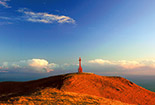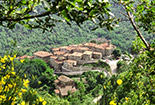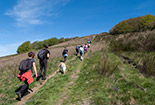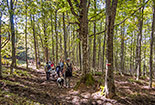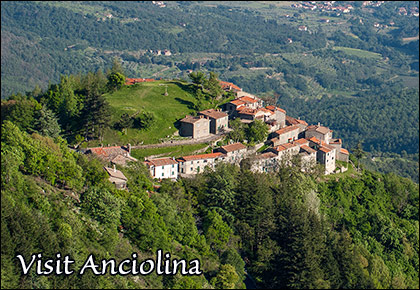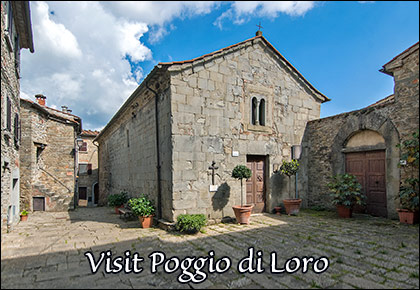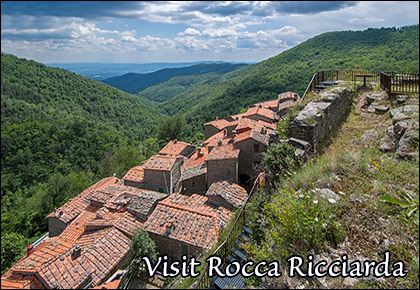From an ancient castle to the grassy ridge
itinerary on the Valdarno Pratomagno: from Trappola to Bottigliana and Pozza Nera
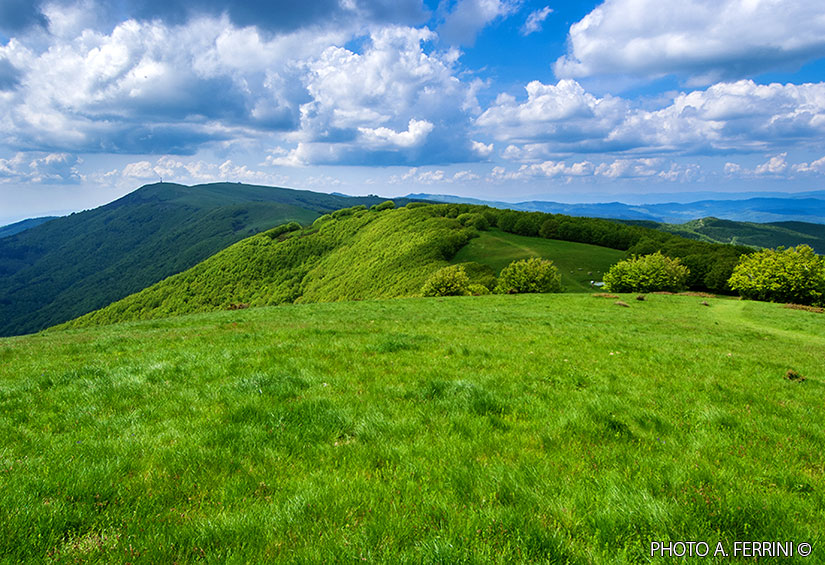
Texts and photos by Alessandro Ferrini ©
80 images in sequence to learn about this itinerary in Pratomagno. Click to start the virtual excursion
From the village of Trappola, originally a medieval castle, to the Pratomagno ridge
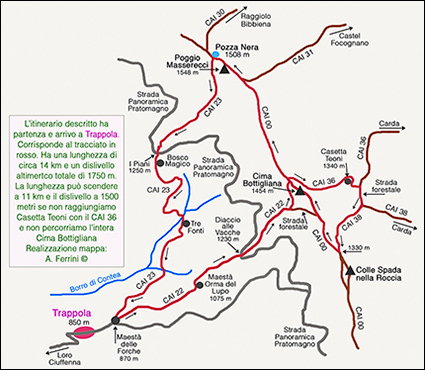 With the circular route that we describe in this web section we will first of all get to know the splendid village of Trappola, the starting and finishing point of this itinerary of approximately eleven kilometres. Length which can increase by three kilometers if we want to cross a splendid forest where we will find the Casetta del Teoni bivouac, we will also cover the entire Cima Bottigliana. In the first case the total altitude difference is approximately 1500 metres, with the longer route the difference in altitude rises to 1750 metres. The itinerary is considered to be of medium physical effort. Trappola is a mountain hamlet in the municipality of Loro Ciuffenna at 850 meters above sea level. From the capital you can reach it by car in about eight kilometers following the signs FRAZIONO MONTANE. Also by car you can reach Trappola from above, via three kilometers of road that connects the village to the panoramic road of Pratomagno sul Valdarno. The photo on the right, taken from this last street, shows us the shape and size of Trappola, but, even more interestingly, it shows its geographical location. It is located on a large rocky spur that emerges from the steep Valdarno slopes of Pratomagno. This position allows for a broad view of the valley below and beyond. Furthermore, since ancient times, a road rose from the valley floor (in particular from the Pieve di Gropina, a church of early medieval origin) to this area which split in Trappola and with its two branches reached the crest of the mountain in two places today represented by Cima Bottigliana and, further north, from Pozza Nera, next to Poggio Masserecci. These two ancient roads are today the CAI 22 and CAI 23 routes. It is along these paths and on the stretch of ridge that connects them that the itinerary we are about to follow unfolds. The history of Trappola is linked to a legend which tells that at the time of Federico Barbarossa (second half of the 12th century) some German and Roman nobles, after having got lost in this area of the mountain, then found by shepherds, considered the place particularly suitable for building their fortified residence. Sticking instead to history, the first known document that talks about the Trappola Castle dates back to 1191 and cites it as a place of control and defense of the territories belonging to the noble and powerful Guidi family, known as the Lords of the upper Casentino. In an alley behind the church you can notice a wall that is an integral part of a house, but with a shape and stone very different from the others. There is a small plaque where it is reported that this is what remains of an eighteen meter high watchtower.
With the circular route that we describe in this web section we will first of all get to know the splendid village of Trappola, the starting and finishing point of this itinerary of approximately eleven kilometres. Length which can increase by three kilometers if we want to cross a splendid forest where we will find the Casetta del Teoni bivouac, we will also cover the entire Cima Bottigliana. In the first case the total altitude difference is approximately 1500 metres, with the longer route the difference in altitude rises to 1750 metres. The itinerary is considered to be of medium physical effort. Trappola is a mountain hamlet in the municipality of Loro Ciuffenna at 850 meters above sea level. From the capital you can reach it by car in about eight kilometers following the signs FRAZIONO MONTANE. Also by car you can reach Trappola from above, via three kilometers of road that connects the village to the panoramic road of Pratomagno sul Valdarno. The photo on the right, taken from this last street, shows us the shape and size of Trappola, but, even more interestingly, it shows its geographical location. It is located on a large rocky spur that emerges from the steep Valdarno slopes of Pratomagno. This position allows for a broad view of the valley below and beyond. Furthermore, since ancient times, a road rose from the valley floor (in particular from the Pieve di Gropina, a church of early medieval origin) to this area which split in Trappola and with its two branches reached the crest of the mountain in two places today represented by Cima Bottigliana and, further north, from Pozza Nera, next to Poggio Masserecci. These two ancient roads are today the CAI 22 and CAI 23 routes. It is along these paths and on the stretch of ridge that connects them that the itinerary we are about to follow unfolds. The history of Trappola is linked to a legend which tells that at the time of Federico Barbarossa (second half of the 12th century) some German and Roman nobles, after having got lost in this area of the mountain, then found by shepherds, considered the place particularly suitable for building their fortified residence. Sticking instead to history, the first known document that talks about the Trappola Castle dates back to 1191 and cites it as a place of control and defense of the territories belonging to the noble and powerful Guidi family, known as the Lords of the upper Casentino. In an alley behind the church you can notice a wall that is an integral part of a house, but with a shape and stone very different from the others. There is a small plaque where it is reported that this is what remains of an eighteen meter high watchtower. 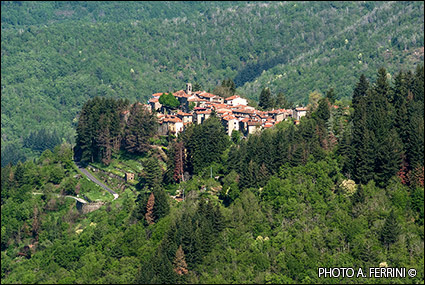 In an alley below the church we can see a series of large rocks like a wall. These boulders were part of the surrounding walls of the castle which in the first half of the 14th century was much disputed, changing owners in the space of a few years. From the Pazzi family, to whom the Guidi family had sold it, it passed to the Ubertini family of Soffena. In 1329 it was purchased by the very powerful Ricasoli family who, with Bindaccio, undertook their own sort of challenge with the Florentine Republic for the dominion of Valdarno. After Bindaccio's death the Signoria of Florence confiscated this castle and the surrounding territory. In 1564, however, Cosimo I, in recognition of the important services provided by some members of the Ricasoli family during the war against Siena, returned this area of Pratomagno to the powerful family who regained possession of it with the title of Barons. In the following years we witnessed the birth of the village that we can visit today. Its inhabitants were woodcutters, shepherds and charcoal burners who worked for the Ricasoli family. Today the town of Trappola appears very tidy, with paved villages and well-kept homes. In good weather it becomes a real garden for the many flowers that color alleys, villages and private gardens. This despite the fact that the place only has around ten permanent inhabitants. In the summer, however, Trappola fills up with people and beautiful initiatives. The delightful church is dedicated to San Jacopo. Its original style was Romanesque, today completely lost due to many renovations. Three hundred meters beyond the end of the town, in the direction of Pratomagno, is the Maestà delle Forche. To the right and left of this religious building we find the CAI 22 and CAI 23 routes, so it is the starting and arrival point of our excursion. The position of this majesty is not accidental. The two CAI routes were once two roads traveled daily by many men to go to work in the woods, a very tiring and often dangerous job. It was customary to begin and end these hard days with a prayer. The building could also represent a shelter in case of bad weather. We begin our walk on CAI 22 which we can take passing both to the right and left of the majesty. We are at 870 meters above sea level, about 3.5 kilometers await us to reach the 1450 meters of Cima Bottigliana. The route immediately begins to climb and from the first meters it presents a clear pavement, the asphalt of the past. It is, in fact, a mule track and these roads had to be traveled on foot and with working animals such as horses, donkeys and mules in all seasons and even on muddy ground. After a few hundred meters we find a path on the left that leads to Le Tre Fonti, along the CAI 23. We will pass through this place on the way back, now we go right and continue climbing. From the crossroads in just over five hundred meters we reach another small building called Maestà dell'Orma del Lupo, we are at 1075 meters. The place is accompanied by a legend that explains its name.
In an alley below the church we can see a series of large rocks like a wall. These boulders were part of the surrounding walls of the castle which in the first half of the 14th century was much disputed, changing owners in the space of a few years. From the Pazzi family, to whom the Guidi family had sold it, it passed to the Ubertini family of Soffena. In 1329 it was purchased by the very powerful Ricasoli family who, with Bindaccio, undertook their own sort of challenge with the Florentine Republic for the dominion of Valdarno. After Bindaccio's death the Signoria of Florence confiscated this castle and the surrounding territory. In 1564, however, Cosimo I, in recognition of the important services provided by some members of the Ricasoli family during the war against Siena, returned this area of Pratomagno to the powerful family who regained possession of it with the title of Barons. In the following years we witnessed the birth of the village that we can visit today. Its inhabitants were woodcutters, shepherds and charcoal burners who worked for the Ricasoli family. Today the town of Trappola appears very tidy, with paved villages and well-kept homes. In good weather it becomes a real garden for the many flowers that color alleys, villages and private gardens. This despite the fact that the place only has around ten permanent inhabitants. In the summer, however, Trappola fills up with people and beautiful initiatives. The delightful church is dedicated to San Jacopo. Its original style was Romanesque, today completely lost due to many renovations. Three hundred meters beyond the end of the town, in the direction of Pratomagno, is the Maestà delle Forche. To the right and left of this religious building we find the CAI 22 and CAI 23 routes, so it is the starting and arrival point of our excursion. The position of this majesty is not accidental. The two CAI routes were once two roads traveled daily by many men to go to work in the woods, a very tiring and often dangerous job. It was customary to begin and end these hard days with a prayer. The building could also represent a shelter in case of bad weather. We begin our walk on CAI 22 which we can take passing both to the right and left of the majesty. We are at 870 meters above sea level, about 3.5 kilometers await us to reach the 1450 meters of Cima Bottigliana. The route immediately begins to climb and from the first meters it presents a clear pavement, the asphalt of the past. It is, in fact, a mule track and these roads had to be traveled on foot and with working animals such as horses, donkeys and mules in all seasons and even on muddy ground. After a few hundred meters we find a path on the left that leads to Le Tre Fonti, along the CAI 23. We will pass through this place on the way back, now we go right and continue climbing. From the crossroads in just over five hundred meters we reach another small building called Maestà dell'Orma del Lupo, we are at 1075 meters. The place is accompanied by a legend that explains its name. 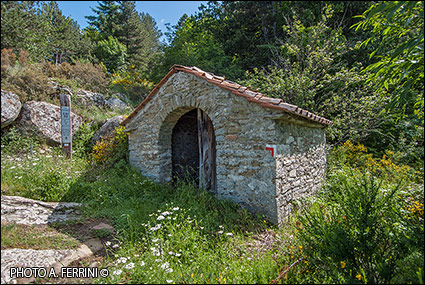 It is said that Saint Francis on his way from Valdarno, or Florence, towards La Verna was using the mule track, now CAI 22, to climb Pratomagno. At this point he encountered a pack of hungry wolves. One of those ferocious animals, the largest, intervened between Francesco and the other wolves, which he chased back into the woods with an impressive growl. For that miraculous event to be remembered, the rock became soft as butter so that the big wolf left an imprint on it. On that footprint a stone hut was built which for many years hosted those who found themselves working in these woods. The fact just narrated is clearly a legend, but be careful, certain traditions never arise from nothing. It is probable that CAI 22 was once a route not of Saint Francis, but of his subsequent followers in their movements from Verna to Valdarno. The Majesty of the Orma del Lupo is located on a rocky clearing and from here we have a wide panorama, particularly towards the Pratomagno massif where we can distinguish its large famous cross. Up to here, along the kilometer just traveled on CAI 22, we have encountered a mixed forest, beyond the Maestà Orma del Lupo the presence of beech becomes increasingly greater. In another kilometer we reach the Strada Panoramica del Pratomagno, we have reached 1230 meters above sea level. The area where path 22 and the driveway intersect is called Diaccio alla Vacche (the term diaccio indicated places equipped with a light fence used for temporary stops for animals during their movements. In Maremma they were also called "diaccia ”, were used in the transhumance of sheep). Beyond the panoramic road, CAI 22 climbs steeply for a hundred meters, then presents a more modest climb and also a short descent into a forest that has become even more beautiful and majestic, now made up almost entirely of beech trees. After less than a kilometer we reach a building: the Casetta Bottigliana. Reduced to ruins, it was completely rebuilt in 2021 and 2022 and its name became Bivacco Bottigliana, a very hospitable structure equipped with a nice table and also services. There is an equipped area around it, so it can be an ideal place for a comfortable breakfast or packed lunch. The building, like others in this mountain, was built in the second half of the nineteenth century to house woodcutters and charcoal burners, and also shepherds since we are now two hundred meters from the wide meadows of the Pratomagno ridge which for centuries represented a huge pasture. Indeed, it is reasonable to assume that in a not too distant past the lawns reached the building. Then, with the abandonment of sheep farming and the consequent cessation of pasture care, the vegetation advanced undisturbed.
It is said that Saint Francis on his way from Valdarno, or Florence, towards La Verna was using the mule track, now CAI 22, to climb Pratomagno. At this point he encountered a pack of hungry wolves. One of those ferocious animals, the largest, intervened between Francesco and the other wolves, which he chased back into the woods with an impressive growl. For that miraculous event to be remembered, the rock became soft as butter so that the big wolf left an imprint on it. On that footprint a stone hut was built which for many years hosted those who found themselves working in these woods. The fact just narrated is clearly a legend, but be careful, certain traditions never arise from nothing. It is probable that CAI 22 was once a route not of Saint Francis, but of his subsequent followers in their movements from Verna to Valdarno. The Majesty of the Orma del Lupo is located on a rocky clearing and from here we have a wide panorama, particularly towards the Pratomagno massif where we can distinguish its large famous cross. Up to here, along the kilometer just traveled on CAI 22, we have encountered a mixed forest, beyond the Maestà Orma del Lupo the presence of beech becomes increasingly greater. In another kilometer we reach the Strada Panoramica del Pratomagno, we have reached 1230 meters above sea level. The area where path 22 and the driveway intersect is called Diaccio alla Vacche (the term diaccio indicated places equipped with a light fence used for temporary stops for animals during their movements. In Maremma they were also called "diaccia ”, were used in the transhumance of sheep). Beyond the panoramic road, CAI 22 climbs steeply for a hundred meters, then presents a more modest climb and also a short descent into a forest that has become even more beautiful and majestic, now made up almost entirely of beech trees. After less than a kilometer we reach a building: the Casetta Bottigliana. Reduced to ruins, it was completely rebuilt in 2021 and 2022 and its name became Bivacco Bottigliana, a very hospitable structure equipped with a nice table and also services. There is an equipped area around it, so it can be an ideal place for a comfortable breakfast or packed lunch. The building, like others in this mountain, was built in the second half of the nineteenth century to house woodcutters and charcoal burners, and also shepherds since we are now two hundred meters from the wide meadows of the Pratomagno ridge which for centuries represented a huge pasture. Indeed, it is reasonable to assume that in a not too distant past the lawns reached the building. Then, with the abandonment of sheep farming and the consequent cessation of pasture care, the vegetation advanced undisturbed. 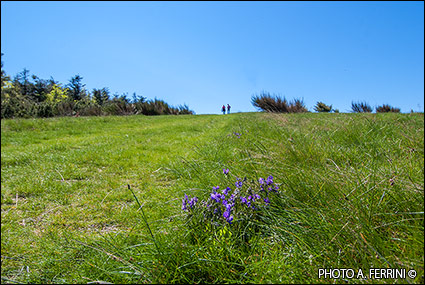 Fifty meters from the building, in the woods, there is a large boulder called by some the "Shepherd's Cave". We recommend going and seeing it, for its shape, its geological conformation, and the chiselled inscription underneath it. These particularities and how to get there are shown on pages 24 to 27 of the sequence accessed with the icons. Continuing on CAI 22 from the Bottigliana Bivacco, in two hundred meters we arrive at the border between woods and meadows, these now also covered by many shrubs. We are at 1395 meters and here we find a crossroads. CAI 22 heads left, going up. On the right, however, an almost flat forest track continues. At this point, with the help of the map, we can choose between three routes. The shortest is to continue on path 22 which in about four hundred meters takes us to the CAI 00 ridge which we will take towards the north, leaving Cima Bottigliana behind us. Otherwise we can take the forest track which in three hundred meters still leads us to the 00, but to the southern part of Cima Bottigliana which we will then have to follow. In this way we will lengthen the route by five hundred meters and increase the active difference in altitude by about thirty metres, but we will have the pleasure of walking on one of the most beautiful hills of Pratomagno and enjoying the wide panoramas it offers. We describe the third route, the longest (about three kilometers), but also the most beautiful and interesting. At the crossroads we continue on CAI 22 which, as mentioned, in three hundred meters takes us to the mountain ridge, at 1438 meters above sea level, in the valley between Cima Bottigliana and Poggio del Lupo. This point, even if not indicated as such on the maps, can be considered a real pass because after about fifty meters on the 00 towards north we find a path on the right (CAI 36) that enters the woods and after a few meters begins to descend in a forest made up of fir and beech trees. In about a kilometer it leads us to a large plateau with majestic plants where we find the Casetta del Teoni bivouac, 1340 meters. This building was also built in the second half of the nineteenth century for the use of the people who worked in this area of the mountain. CAI 36 continues to descend to Carda, a mountain hamlet in the municipality of Castel Focognano. It takes about an hour and a half at a good pace to get there. CAI 22 and 36, therefore, are two parts of a single route that connected Trappola and Carda, but also Valdarno and Casentino, through a pass on the Pratomagno ridge. For centuries there was a sort of twinning between the two towns, Trappolini and Cardesi met in the Casetta Teoni area, they worked together, there were commercial exchanges (generally food goods), there were marriages between young people from Carda and Trappola. From Casetta Teoni we continue on CAI 36 which passes in front of the building and after fifty meters turns left. After one hundred meters, at a crossroads, turn left again, but we continue right on a flat forest road which after three hundred meters takes us to a gate on a fence.
Fifty meters from the building, in the woods, there is a large boulder called by some the "Shepherd's Cave". We recommend going and seeing it, for its shape, its geological conformation, and the chiselled inscription underneath it. These particularities and how to get there are shown on pages 24 to 27 of the sequence accessed with the icons. Continuing on CAI 22 from the Bottigliana Bivacco, in two hundred meters we arrive at the border between woods and meadows, these now also covered by many shrubs. We are at 1395 meters and here we find a crossroads. CAI 22 heads left, going up. On the right, however, an almost flat forest track continues. At this point, with the help of the map, we can choose between three routes. The shortest is to continue on path 22 which in about four hundred meters takes us to the CAI 00 ridge which we will take towards the north, leaving Cima Bottigliana behind us. Otherwise we can take the forest track which in three hundred meters still leads us to the 00, but to the southern part of Cima Bottigliana which we will then have to follow. In this way we will lengthen the route by five hundred meters and increase the active difference in altitude by about thirty metres, but we will have the pleasure of walking on one of the most beautiful hills of Pratomagno and enjoying the wide panoramas it offers. We describe the third route, the longest (about three kilometers), but also the most beautiful and interesting. At the crossroads we continue on CAI 22 which, as mentioned, in three hundred meters takes us to the mountain ridge, at 1438 meters above sea level, in the valley between Cima Bottigliana and Poggio del Lupo. This point, even if not indicated as such on the maps, can be considered a real pass because after about fifty meters on the 00 towards north we find a path on the right (CAI 36) that enters the woods and after a few meters begins to descend in a forest made up of fir and beech trees. In about a kilometer it leads us to a large plateau with majestic plants where we find the Casetta del Teoni bivouac, 1340 meters. This building was also built in the second half of the nineteenth century for the use of the people who worked in this area of the mountain. CAI 36 continues to descend to Carda, a mountain hamlet in the municipality of Castel Focognano. It takes about an hour and a half at a good pace to get there. CAI 22 and 36, therefore, are two parts of a single route that connected Trappola and Carda, but also Valdarno and Casentino, through a pass on the Pratomagno ridge. For centuries there was a sort of twinning between the two towns, Trappolini and Cardesi met in the Casetta Teoni area, they worked together, there were commercial exchanges (generally food goods), there were marriages between young people from Carda and Trappola. From Casetta Teoni we continue on CAI 36 which passes in front of the building and after fifty meters turns left. After one hundred meters, at a crossroads, turn left again, but we continue right on a flat forest road which after three hundred meters takes us to a gate on a fence. 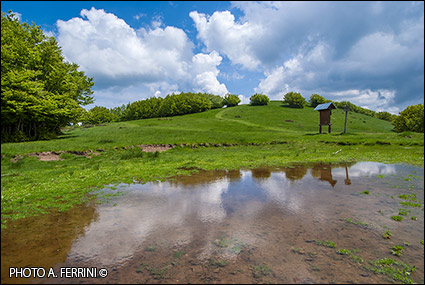 After passing it we join the CAI 38, another route that comes from Carda and ends up on the Pratomagno ridge towards which we head and reach in about six hundred meters of light ups and downs through a beautiful beech forest. We will join CAI 00 on the ridge, at 1330 meters above sea level, in the valley between Colle della Spada nella Roccia and Cima Bottigliana towards which we will begin to climb. From this hill which reaches 1454 meters above sea level we will enjoy wide views and after about a kilometer we will find ourselves again at the crossroads between CAI 00 and CAI 22. We continue on the ridge route which immediately presents us with the steepest climb of the entire itinerary , fortunately short: the one that takes us up to 1488 meters of Poggio del Lupo. From here the CAI 00 continues for just over a kilometer without major variations in altitude, up to the valley preceding Poggio Masserecci where, on the right, a historic route begins to descend, now traced by the CAI 31. The road, keeping to the ridge of a sort of the Pratomagno buttress it first descends to Castel Focognano, the first documented castle of the Arezzo bishopric in the Casentino area, 1022, and then continues to Pieve di Socana, an Etruscan site which saw its first Christian church in the early Middle Ages. The CAI 00 passes next to Poggio Masserecci, but we recommend climbing this hill (the last ascent of this itinerary). The small effort will be rewarded by the beautiful panorama it offers from its 1548 meters. Furthermore, from up here it will be much more beautiful to reach the Pozza Nera which is located in the large basin after Poggio Masserecci. It is a small pond (about ten meters in diameter) certainly artificial, created on an unknown source in which era. For several years now, we have only found water there in the rainy seasons. It was used to water the animals that grazed on this large meadow and also those who passed by. In fact, even if not marked on the maps, we find ourselves on another important "gap" of the Pratomagno. From this basin a road has descended for centuries towards the Casentino valley floor (today CAI 30) which, passing through Raggiolo, then reached Bibbiena. On the opposite side, the Valdarno side, a road (now CAI 23) descends which, passing through Trappola, reaches Loro Ciuffenna. It is the route we are about to take to return to the starting point of our excursion. From here to the Maestà delle Forche there are approximately 5.5 kilometres. For some years now, CAI 23 has been called Via della Transumanza, so along the way we will also find this indication in addition to the well-known red white signs of the CAI. The route has a very similar layout to CAI 22, it is a couple of kilometers longer, a little more tortuous and has a hundred meters more difference in altitude. For almost four kilometres, up to the Tre Fonti, it is constantly downhill, even steeply. Let's approach it with caution, especially if we have joint problems. The path begins at the Pozza Nera, to the left of it looking at the large cross. In a couple of kilometers it descends to the Strada Panoramica del Pratomagno which crosses at a point called "I Piani", we are at 1250 meters above sea level. After passing the driveway, path 23 continues to descend for the first few meters to the right and alongside a dirt road closed by a barrier. After two hundred meters we will see a beautiful fenced chestnut grove on our left. It is an area today called "Magic Forest".
After passing it we join the CAI 38, another route that comes from Carda and ends up on the Pratomagno ridge towards which we head and reach in about six hundred meters of light ups and downs through a beautiful beech forest. We will join CAI 00 on the ridge, at 1330 meters above sea level, in the valley between Colle della Spada nella Roccia and Cima Bottigliana towards which we will begin to climb. From this hill which reaches 1454 meters above sea level we will enjoy wide views and after about a kilometer we will find ourselves again at the crossroads between CAI 00 and CAI 22. We continue on the ridge route which immediately presents us with the steepest climb of the entire itinerary , fortunately short: the one that takes us up to 1488 meters of Poggio del Lupo. From here the CAI 00 continues for just over a kilometer without major variations in altitude, up to the valley preceding Poggio Masserecci where, on the right, a historic route begins to descend, now traced by the CAI 31. The road, keeping to the ridge of a sort of the Pratomagno buttress it first descends to Castel Focognano, the first documented castle of the Arezzo bishopric in the Casentino area, 1022, and then continues to Pieve di Socana, an Etruscan site which saw its first Christian church in the early Middle Ages. The CAI 00 passes next to Poggio Masserecci, but we recommend climbing this hill (the last ascent of this itinerary). The small effort will be rewarded by the beautiful panorama it offers from its 1548 meters. Furthermore, from up here it will be much more beautiful to reach the Pozza Nera which is located in the large basin after Poggio Masserecci. It is a small pond (about ten meters in diameter) certainly artificial, created on an unknown source in which era. For several years now, we have only found water there in the rainy seasons. It was used to water the animals that grazed on this large meadow and also those who passed by. In fact, even if not marked on the maps, we find ourselves on another important "gap" of the Pratomagno. From this basin a road has descended for centuries towards the Casentino valley floor (today CAI 30) which, passing through Raggiolo, then reached Bibbiena. On the opposite side, the Valdarno side, a road (now CAI 23) descends which, passing through Trappola, reaches Loro Ciuffenna. It is the route we are about to take to return to the starting point of our excursion. From here to the Maestà delle Forche there are approximately 5.5 kilometres. For some years now, CAI 23 has been called Via della Transumanza, so along the way we will also find this indication in addition to the well-known red white signs of the CAI. The route has a very similar layout to CAI 22, it is a couple of kilometers longer, a little more tortuous and has a hundred meters more difference in altitude. For almost four kilometres, up to the Tre Fonti, it is constantly downhill, even steeply. Let's approach it with caution, especially if we have joint problems. The path begins at the Pozza Nera, to the left of it looking at the large cross. In a couple of kilometers it descends to the Strada Panoramica del Pratomagno which crosses at a point called "I Piani", we are at 1250 meters above sea level. After passing the driveway, path 23 continues to descend for the first few meters to the right and alongside a dirt road closed by a barrier. After two hundred meters we will see a beautiful fenced chestnut grove on our left. It is an area today called "Magic Forest". 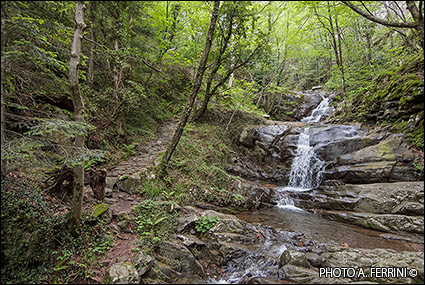 Educational and leisure activities for children are carried out there. In the months of April and May it is very popular with school groups. It can be reached via the dirt road seen shortly before. Beyond the Magic Forest, the CAI 23, or Via della Transumanza, becomes narrow, tortuous and runs through a mixed forest. We are going down towards a stream and we begin to hear the sound of the water. Let's be careful, we are traveling along the most treacherous stretch of the itinerary. The path is narrow, steep, tortuous and we walk for a good part on rock which, if wet, can be very slippery. Near the watercourse we begin to see beautiful waterfalls and countless water features. Let's not get distracted too much and continue to pay attention to where we place our feet. Once we reach the stream we can cross it with a footbridge. Beyond this, CAI 23 changes from a narrow and steep path to a comfortable road which, after a few dozen meters uphill, becomes almost flat. We are now 1.8 kilometers from the Maestà delle Forche, in the place called Tre Fonti, the destination of a comfortable walk from Trappola. At several points the road runs alongside a wall of spectacular rocks. On the opposite side we encounter a majestic silver fir forest. These trees were planted around 1845 by Baron Bettino Ricasoli. From the Tre Fonti with a half-hour walk that we can define as relaxing, we return to the Maestà delle Forche where our excursion ends which introduced us to the historical, naturalistic and legendary aspects of the Pratomagno and great views.
Educational and leisure activities for children are carried out there. In the months of April and May it is very popular with school groups. It can be reached via the dirt road seen shortly before. Beyond the Magic Forest, the CAI 23, or Via della Transumanza, becomes narrow, tortuous and runs through a mixed forest. We are going down towards a stream and we begin to hear the sound of the water. Let's be careful, we are traveling along the most treacherous stretch of the itinerary. The path is narrow, steep, tortuous and we walk for a good part on rock which, if wet, can be very slippery. Near the watercourse we begin to see beautiful waterfalls and countless water features. Let's not get distracted too much and continue to pay attention to where we place our feet. Once we reach the stream we can cross it with a footbridge. Beyond this, CAI 23 changes from a narrow and steep path to a comfortable road which, after a few dozen meters uphill, becomes almost flat. We are now 1.8 kilometers from the Maestà delle Forche, in the place called Tre Fonti, the destination of a comfortable walk from Trappola. At several points the road runs alongside a wall of spectacular rocks. On the opposite side we encounter a majestic silver fir forest. These trees were planted around 1845 by Baron Bettino Ricasoli. From the Tre Fonti with a half-hour walk that we can define as relaxing, we return to the Maestà delle Forche where our excursion ends which introduced us to the historical, naturalistic and legendary aspects of the Pratomagno and great views.



